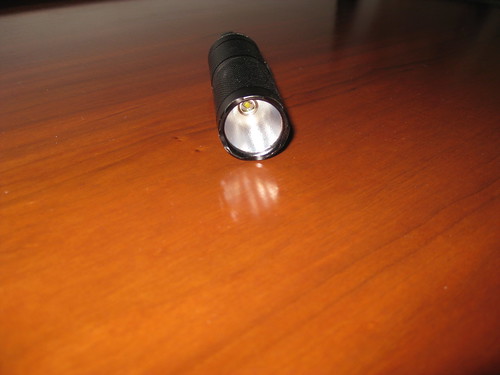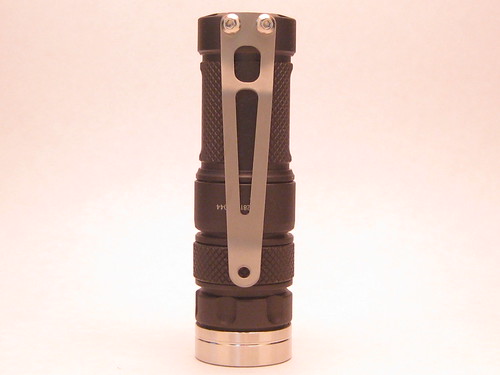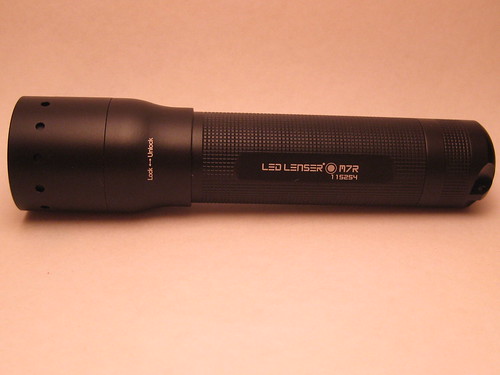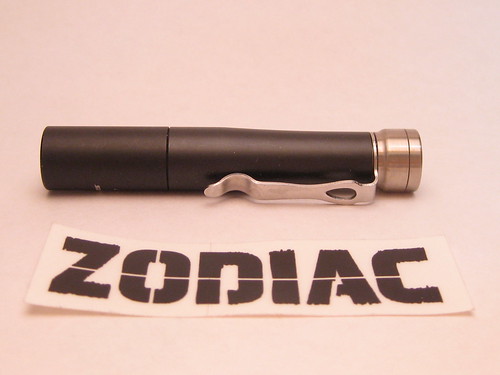The Nightstand Test
When I am testing a flashlight, like I am now (the 47s MMX7), one of the things I do is make sure it is on the nightstand when I go to bed. For me, the nightstand test is one of the basic and crucial parts of figuring out whether or not I like the light. It represents an easy way to test a lot of the features of the light in quick and real world ways.
I never understood the appeal of photographing beam shots on a white wall. I guess they can show you relative tint and beam shape, and maybe brightness, but there are so many ways to trick a camera (or a viewer) that I am skeptical of their utility. There is also impracticality of the whole thing. When do you ever shine a light at a wall like that? A ceiling bounce is the closest thing, and in that scenario, it is the reflected light that is most important. The wall hunting shots just don't reflect what we do when we use our lights, so in addition to all of the trickery problems, its just not helpful.
But the nightstand test IS incredibly helpful. It is simple--can the light get me where I need to be without waking up the whole house? Sometimes I am just making a run to the bathroom. Other times I am checking outside for things that go bump in the night. Either way, it is a very practical and useful test.
First, the nightstand test allows me to judge the UI. Anyone can get just about the most complicated UI working under ideal circumstances, but in the middle of the night your fingers are fumbly and your brain is fuzzy. The press, turn, press and hold routine of some lights just won't cut it. These lights end up producing either too much or not enough light. The Liteflux LF3XT, with its labyrinthine UI lost its place as my go to EDC light because it utterly failed the UI portion of the nightstand test.
Second, the nightstand test helps me judge the low on a light. When I am going downstairs to get a drink of water or going to the bathroom I don't want to wake up the whole house, especially with a little guy a door away. So, a light with a good low, just enough to shine my way down the hall, is perfect. I want it to give me the light I need but not wake up the misses or blow out my night vision. This is one of the reasons I really, really like the JetBeam RRT-01.
Third, the nightstand test helps me judge the high, the beam pattern and the beam quality on a light. Sometimes I need a light to do the exact opposite. In these cases I need it to just punch a hole in the darkness around my house. Usually I find a raccoon or something, but sometimes it is a noisy teeanger or two (or around the 4th of July rednecks down the street shooting off fireworks). Either way, this part of the nightstand test allows me to see just how much of a photon cannon the light really is. This is a good test of a light's ability to "throw" as much of the activity human or raccoon takes place at the end of my driveway, probably 100 feet or so from my bedroom window. This is also a good time to see if the beam has holes or rings in it that distract from or cover up what is illuminated. The recently tested LED Lenser M7R passed all of these varied tests with aplomb.
Finally, the nightstand tests helps me judge the hands-free aspects of the light. Setting a light on my nightstand for easy access all but requires the light to have some form of anti-roll, usually a pocket clip. Using the light to illuminate the kitchen or the medicine cabinet works much better with a good flat tail. Also, if I need to press the light into a hands free role to check something outside, this is a good time to test that as well. All three of these things are hard to find in a light, but a few of my very favorites--like the McGizmo Haiku and my upgraded Preon 1, get high marks in all three categories.
In the end the Nightstand Test is an invaluable tool in assessing the performance of a flashlight. It is a surprisingly easy, quick, and yet still demanding set of tasks for even the most advanced lights. Thus far, the only light to ever score a perfect in every regard has been the Haiku. Even my beloved Aeon loses a little because its rolly-polly form factor. The Nightstand Test is like an NFL combine or baseball agility drill for flashlights--it briefly and quickly tests many of the most important attributes a light can have.
I strongly recommend you try the Nightstand Test. Keep the same light by your bed for a month and see how well it does. If it is your EDC light and it passes this test as well as your regular carry-everyday-tests, then you have a gem. Thus far the only torch that has flexed into both rolls well is, again, the Haiku. It is a classic for a reason.
All of this is a good lead in to the 47s MMX7 review. It did QUITE well on the ole' nightstand.
I never understood the appeal of photographing beam shots on a white wall. I guess they can show you relative tint and beam shape, and maybe brightness, but there are so many ways to trick a camera (or a viewer) that I am skeptical of their utility. There is also impracticality of the whole thing. When do you ever shine a light at a wall like that? A ceiling bounce is the closest thing, and in that scenario, it is the reflected light that is most important. The wall hunting shots just don't reflect what we do when we use our lights, so in addition to all of the trickery problems, its just not helpful.
But the nightstand test IS incredibly helpful. It is simple--can the light get me where I need to be without waking up the whole house? Sometimes I am just making a run to the bathroom. Other times I am checking outside for things that go bump in the night. Either way, it is a very practical and useful test.
First, the nightstand test allows me to judge the UI. Anyone can get just about the most complicated UI working under ideal circumstances, but in the middle of the night your fingers are fumbly and your brain is fuzzy. The press, turn, press and hold routine of some lights just won't cut it. These lights end up producing either too much or not enough light. The Liteflux LF3XT, with its labyrinthine UI lost its place as my go to EDC light because it utterly failed the UI portion of the nightstand test.
Second, the nightstand test helps me judge the low on a light. When I am going downstairs to get a drink of water or going to the bathroom I don't want to wake up the whole house, especially with a little guy a door away. So, a light with a good low, just enough to shine my way down the hall, is perfect. I want it to give me the light I need but not wake up the misses or blow out my night vision. This is one of the reasons I really, really like the JetBeam RRT-01.
Third, the nightstand test helps me judge the high, the beam pattern and the beam quality on a light. Sometimes I need a light to do the exact opposite. In these cases I need it to just punch a hole in the darkness around my house. Usually I find a raccoon or something, but sometimes it is a noisy teeanger or two (or around the 4th of July rednecks down the street shooting off fireworks). Either way, this part of the nightstand test allows me to see just how much of a photon cannon the light really is. This is a good test of a light's ability to "throw" as much of the activity human or raccoon takes place at the end of my driveway, probably 100 feet or so from my bedroom window. This is also a good time to see if the beam has holes or rings in it that distract from or cover up what is illuminated. The recently tested LED Lenser M7R passed all of these varied tests with aplomb.
Finally, the nightstand tests helps me judge the hands-free aspects of the light. Setting a light on my nightstand for easy access all but requires the light to have some form of anti-roll, usually a pocket clip. Using the light to illuminate the kitchen or the medicine cabinet works much better with a good flat tail. Also, if I need to press the light into a hands free role to check something outside, this is a good time to test that as well. All three of these things are hard to find in a light, but a few of my very favorites--like the McGizmo Haiku and my upgraded Preon 1, get high marks in all three categories.
In the end the Nightstand Test is an invaluable tool in assessing the performance of a flashlight. It is a surprisingly easy, quick, and yet still demanding set of tasks for even the most advanced lights. Thus far, the only light to ever score a perfect in every regard has been the Haiku. Even my beloved Aeon loses a little because its rolly-polly form factor. The Nightstand Test is like an NFL combine or baseball agility drill for flashlights--it briefly and quickly tests many of the most important attributes a light can have.
I strongly recommend you try the Nightstand Test. Keep the same light by your bed for a month and see how well it does. If it is your EDC light and it passes this test as well as your regular carry-everyday-tests, then you have a gem. Thus far the only torch that has flexed into both rolls well is, again, the Haiku. It is a classic for a reason.
All of this is a good lead in to the 47s MMX7 review. It did QUITE well on the ole' nightstand.




